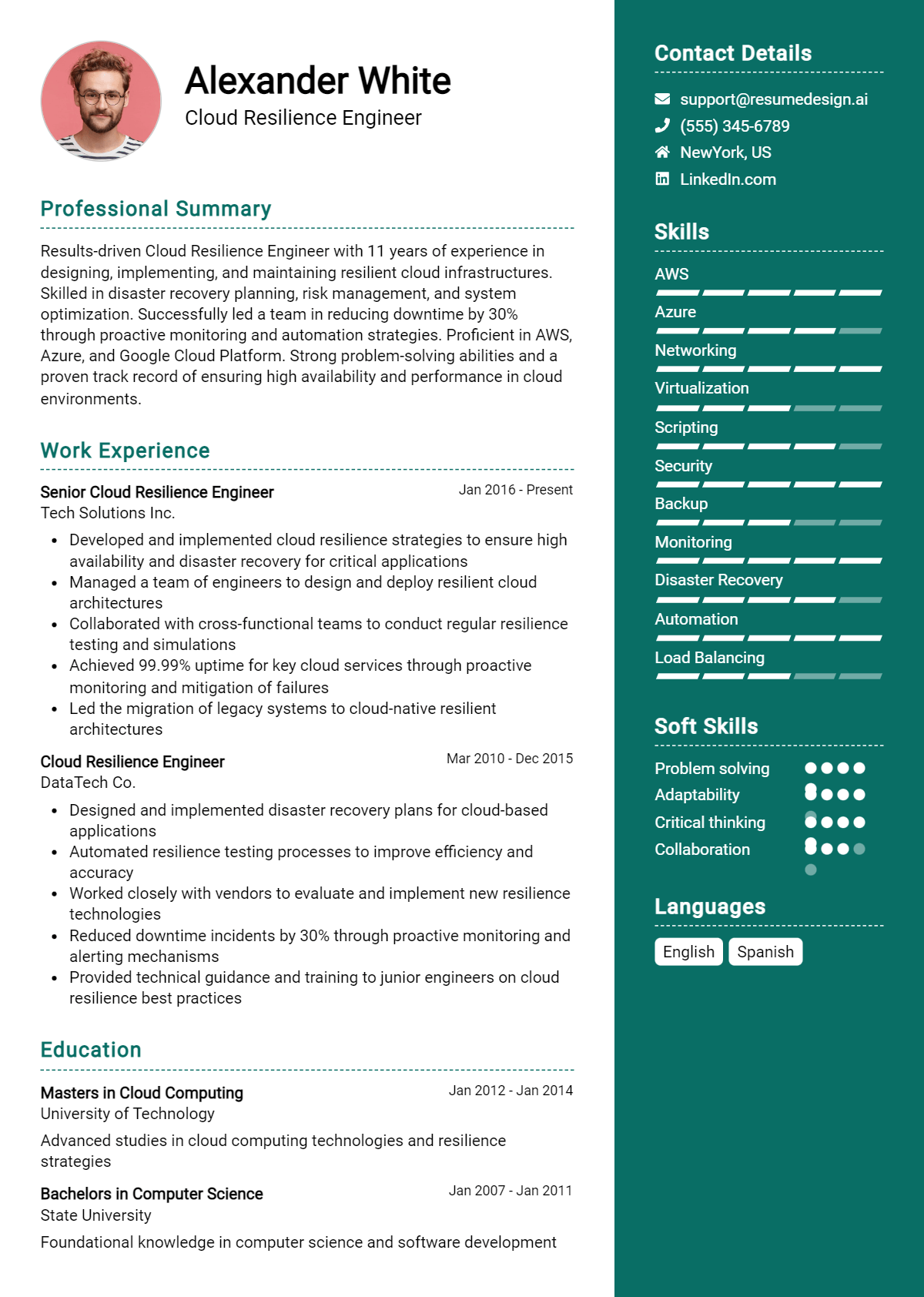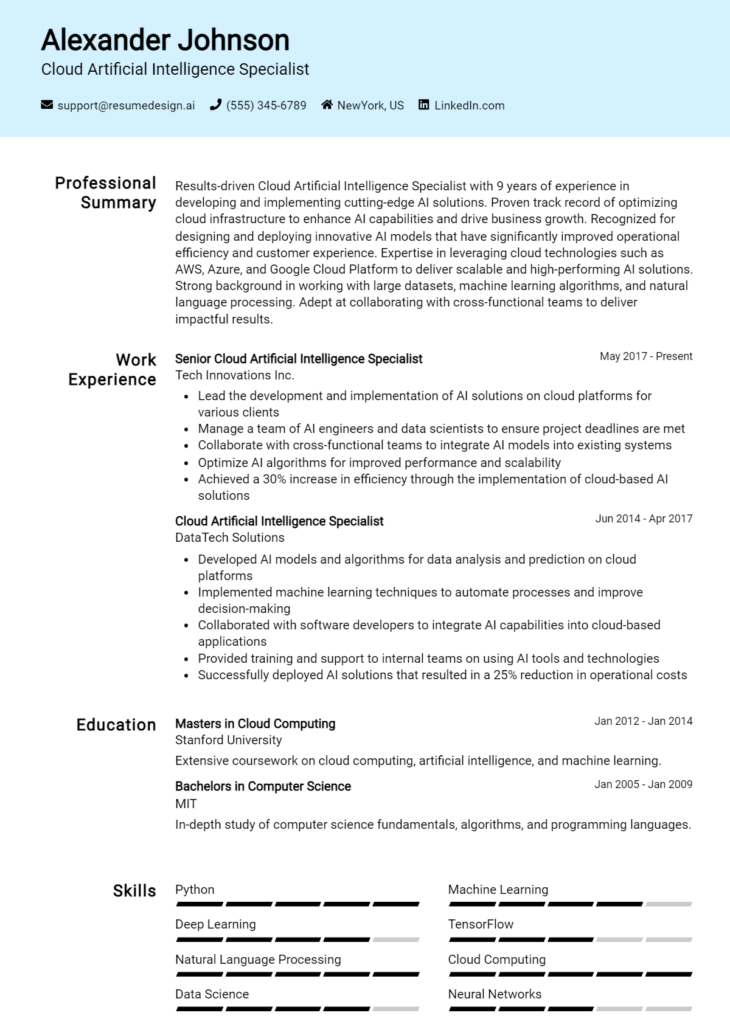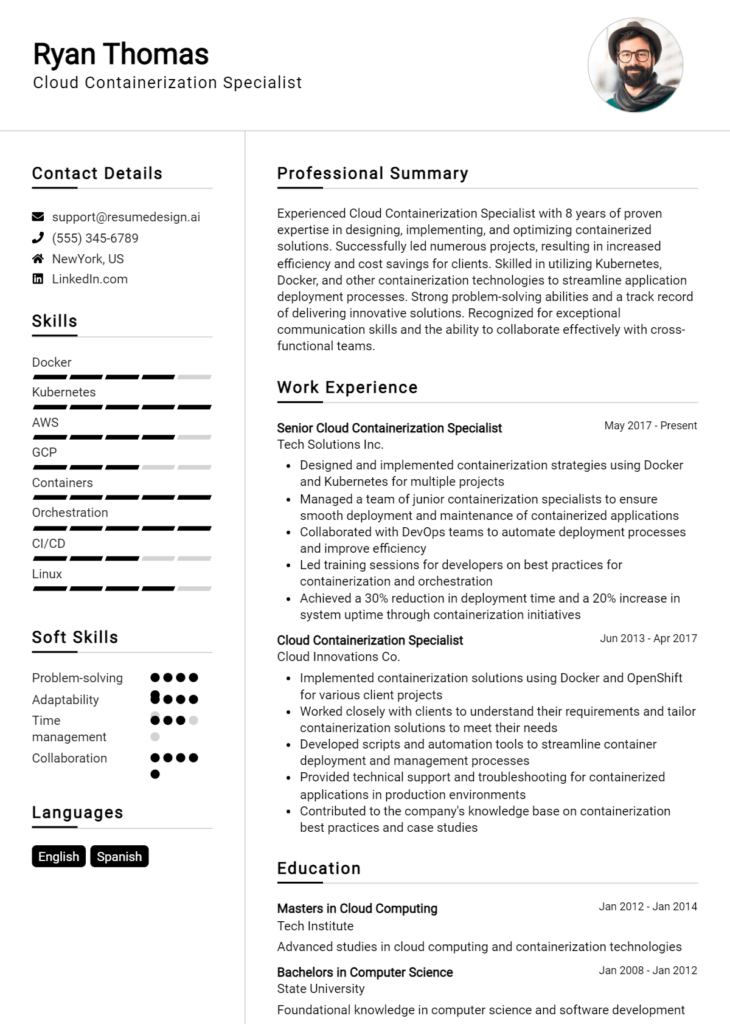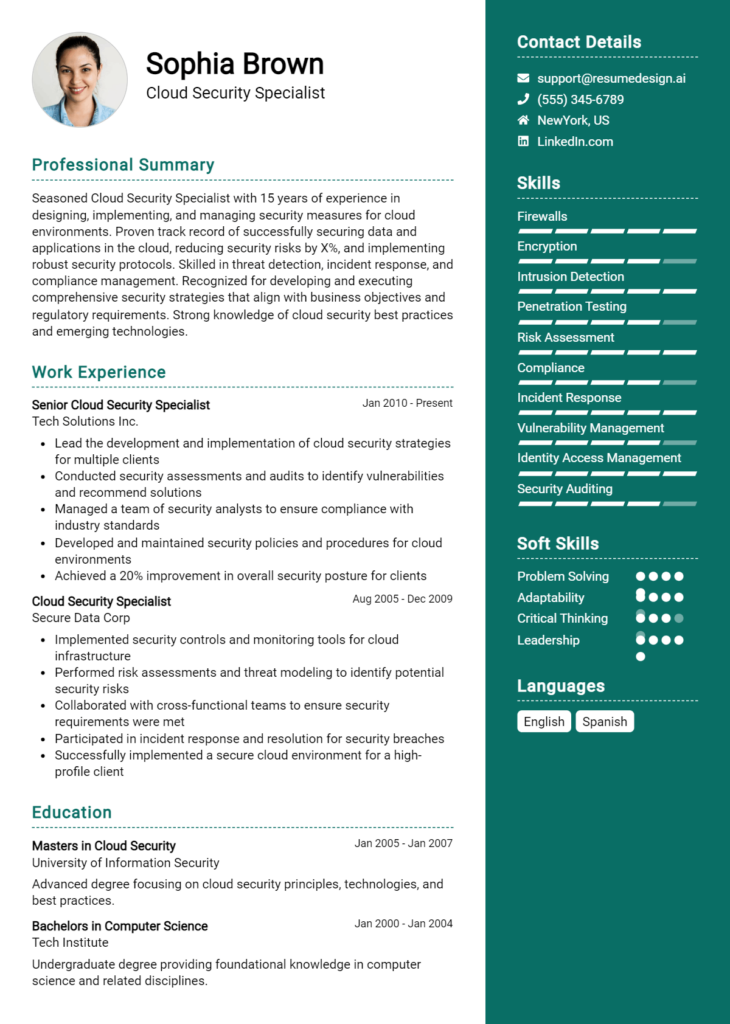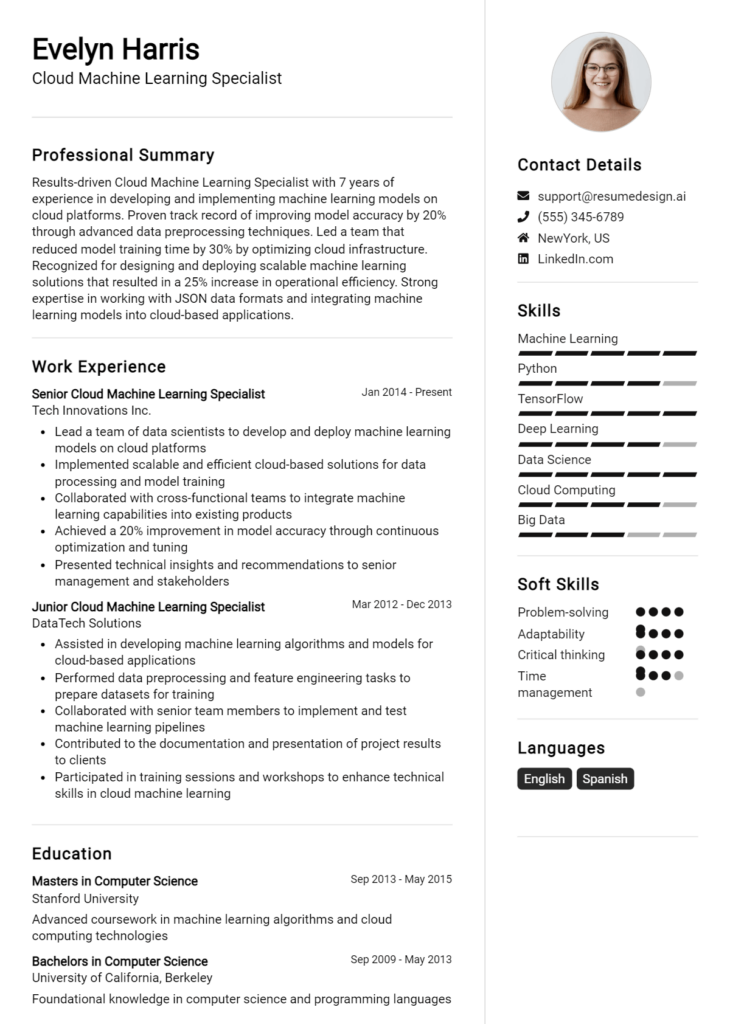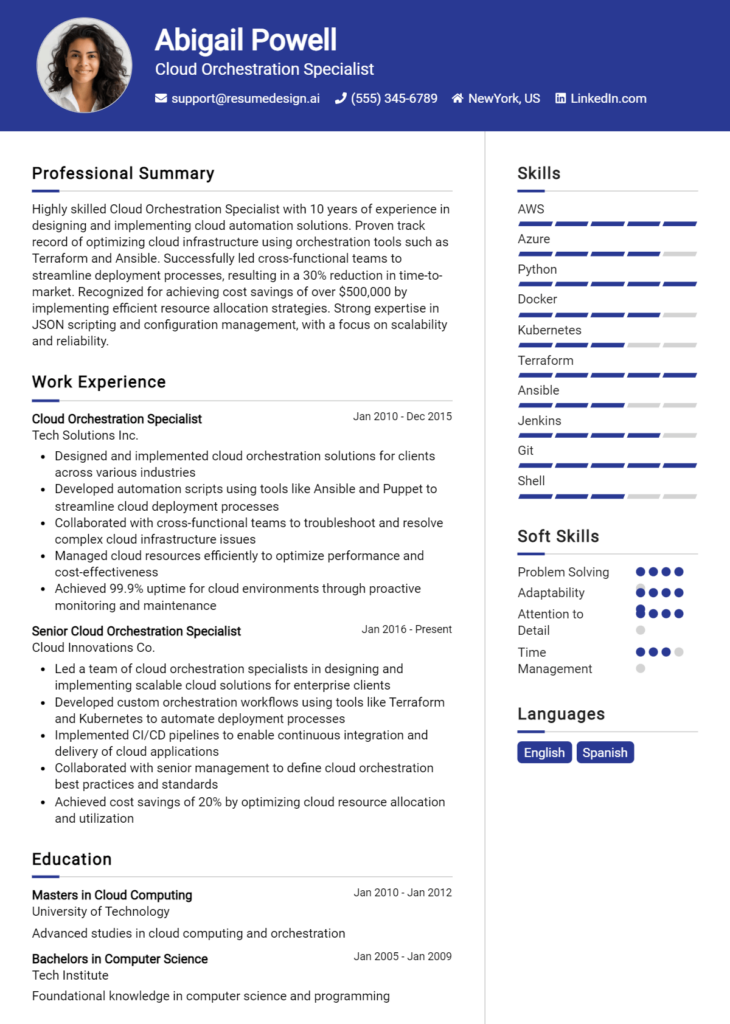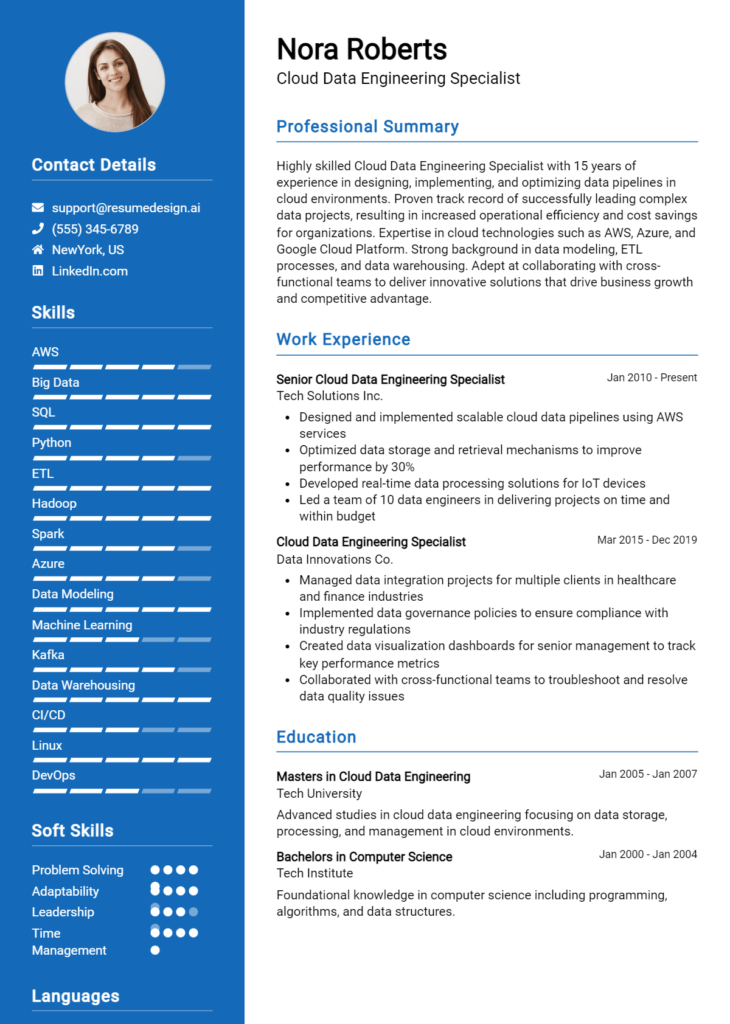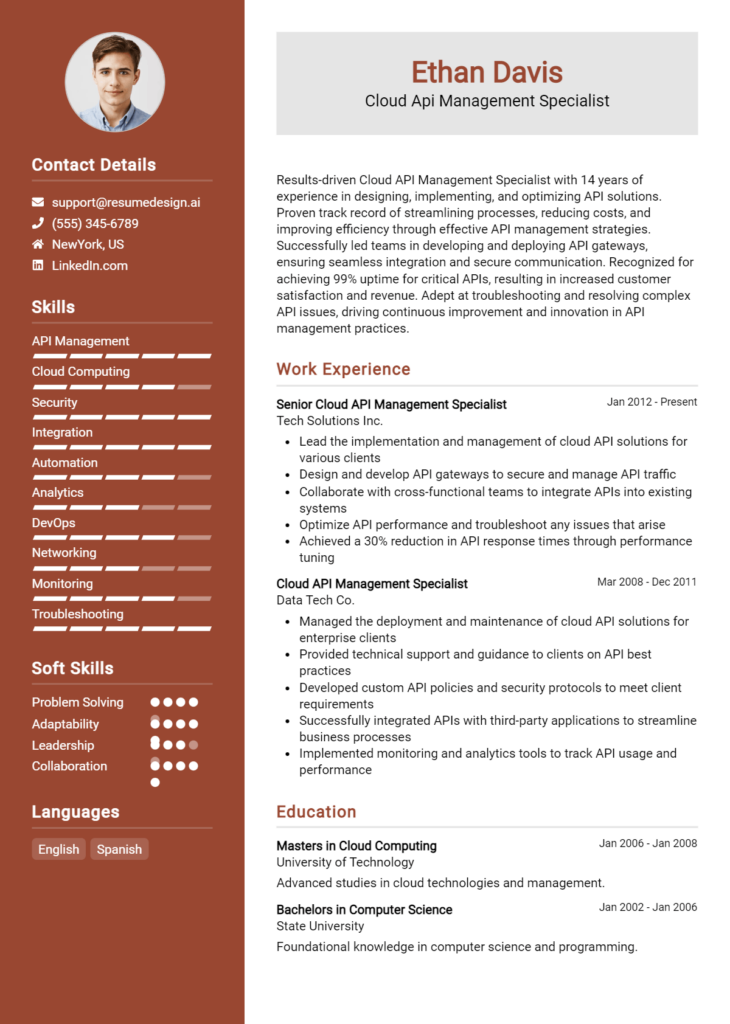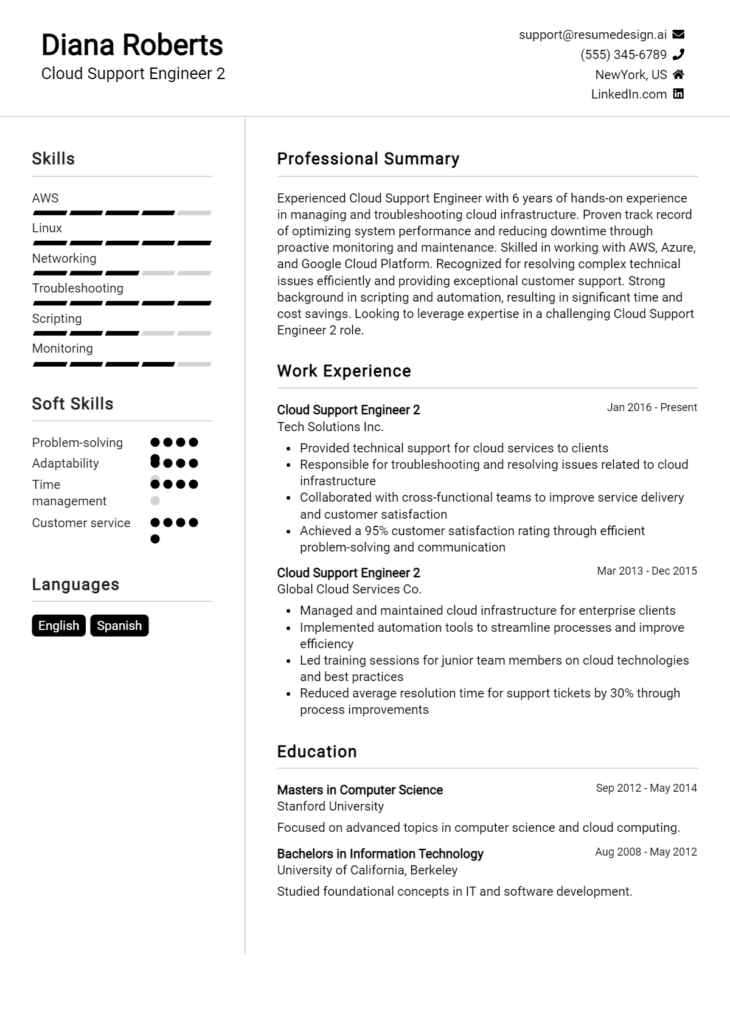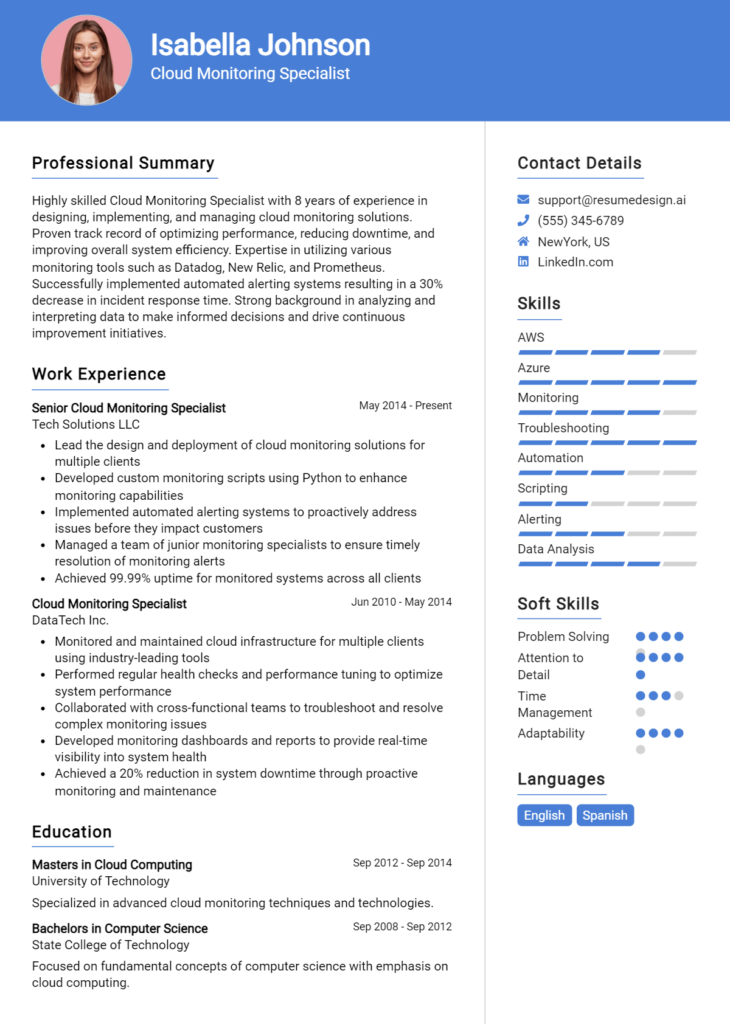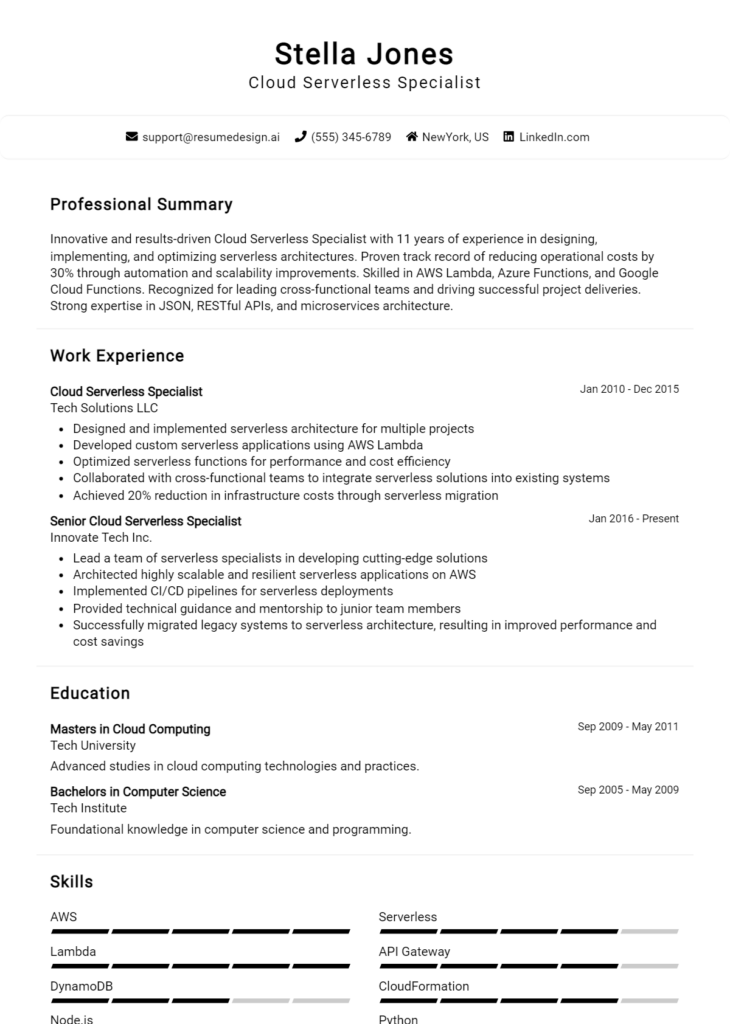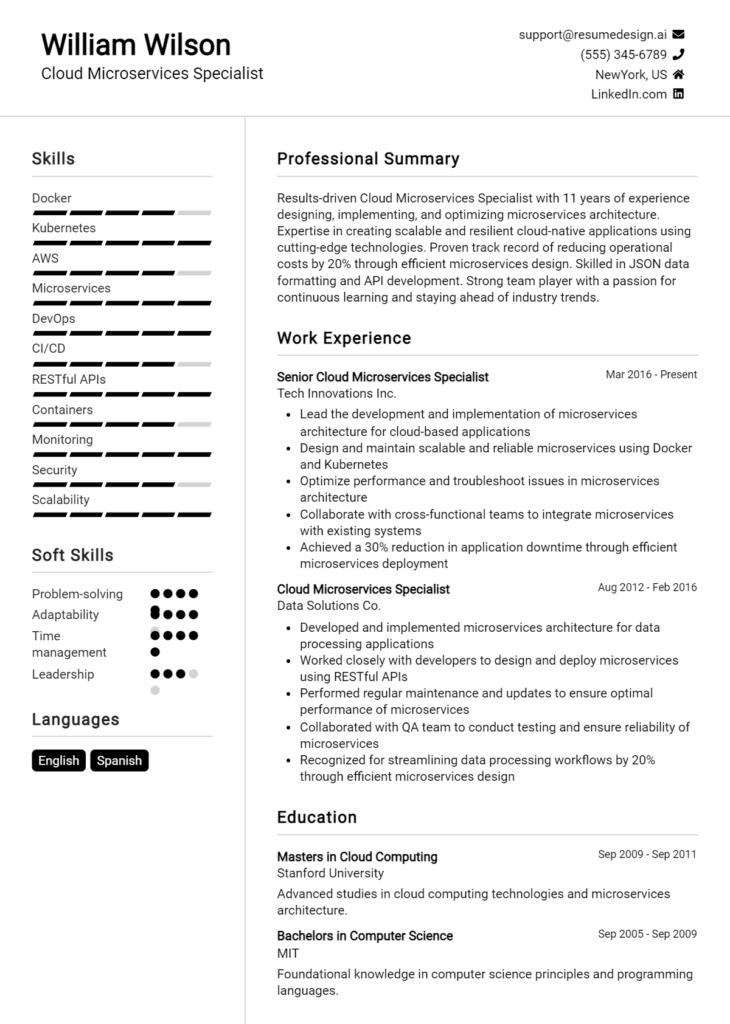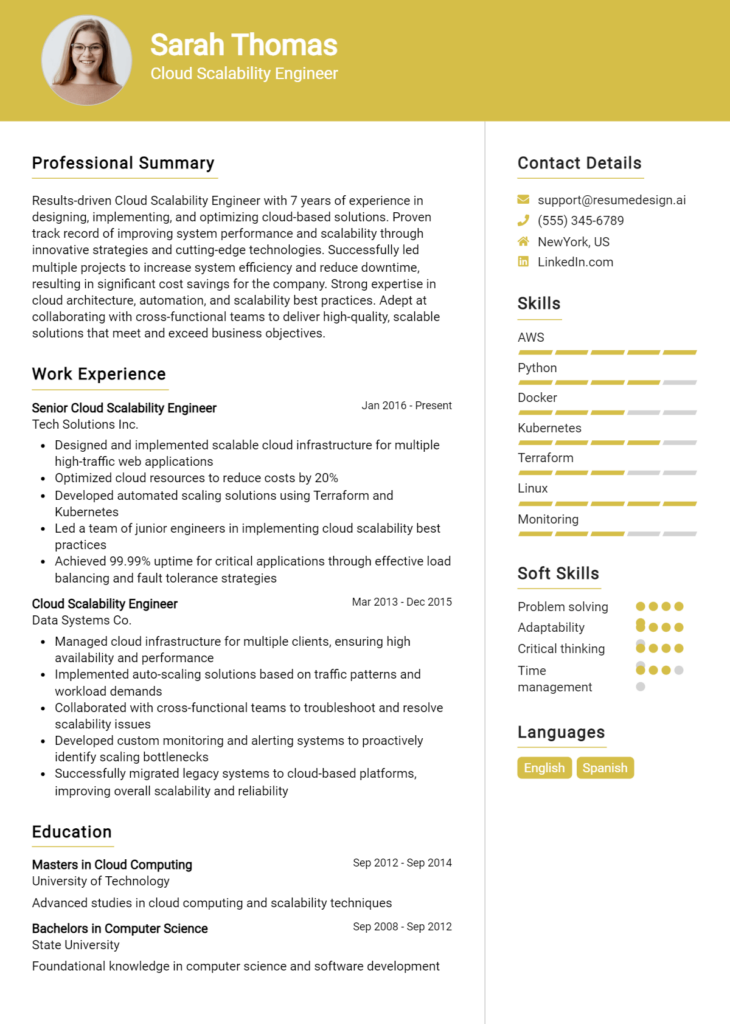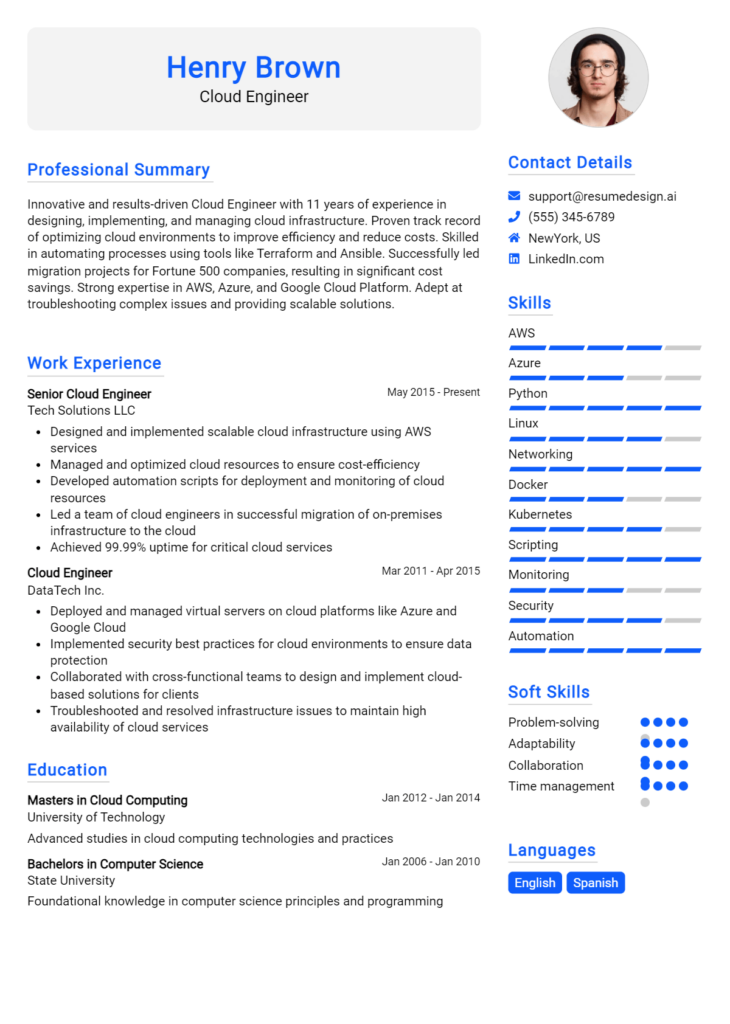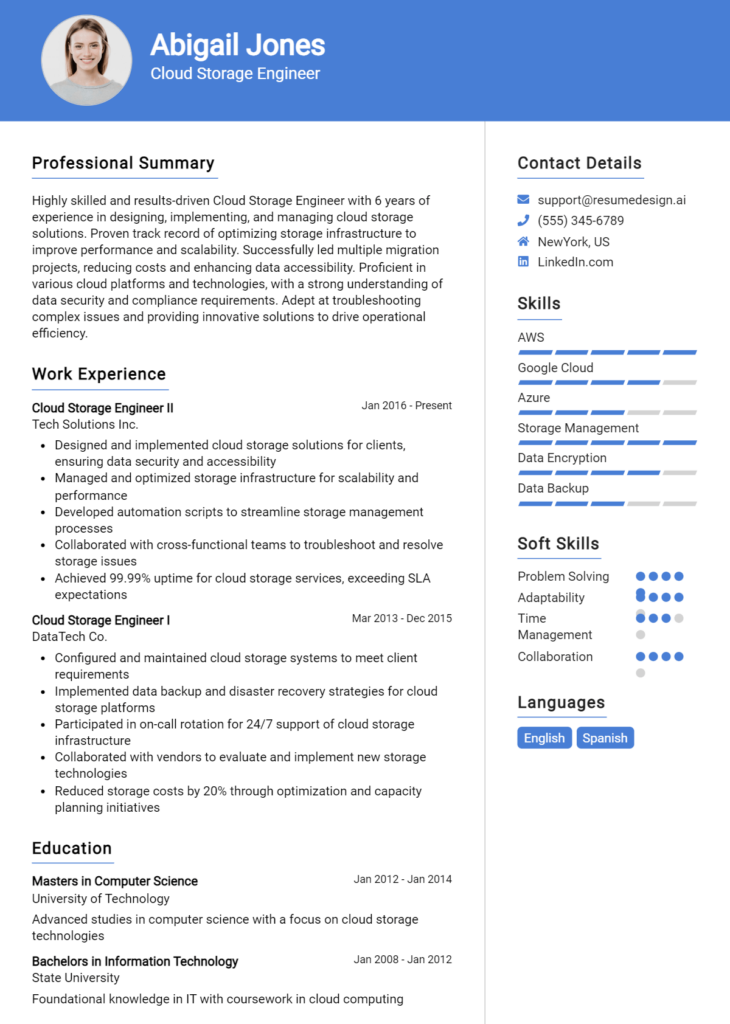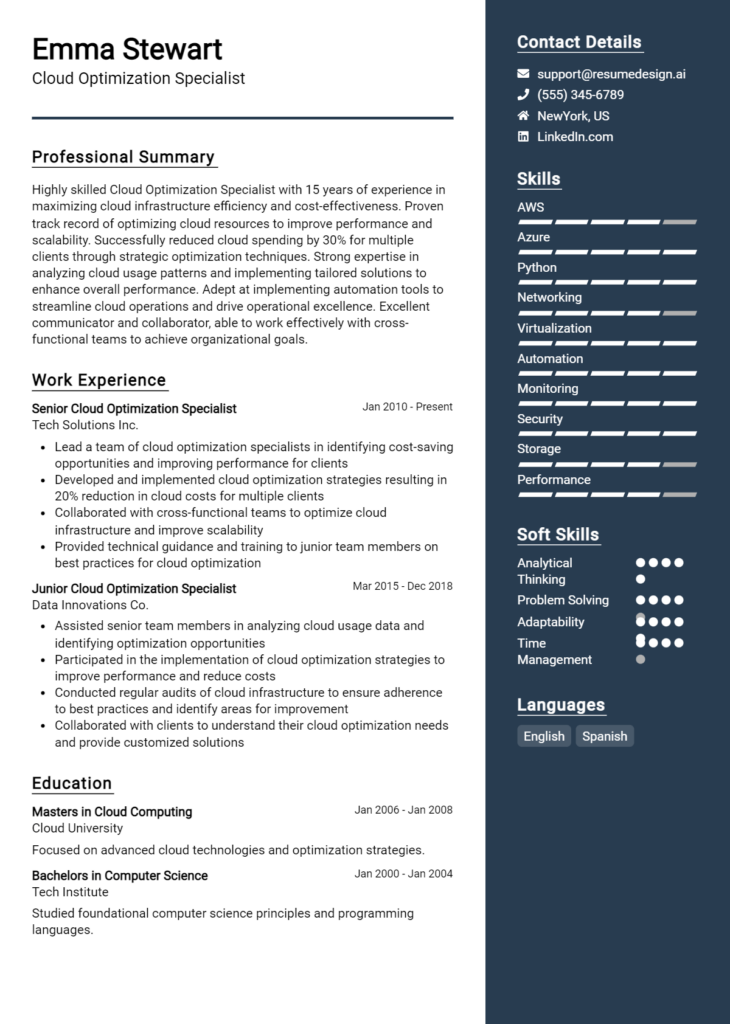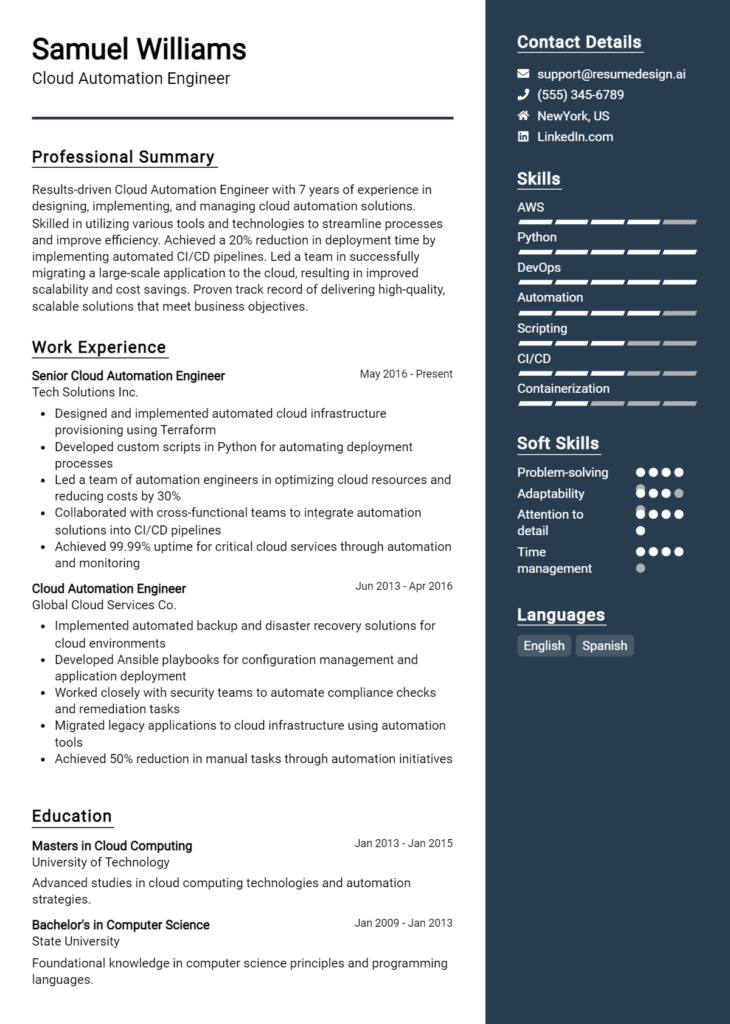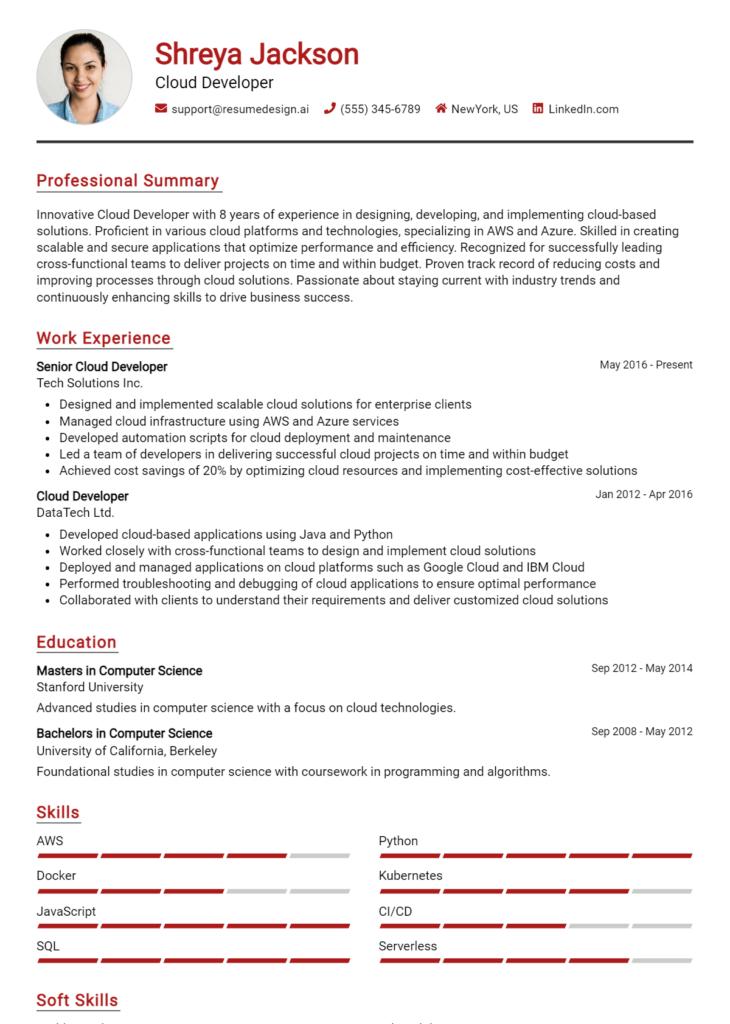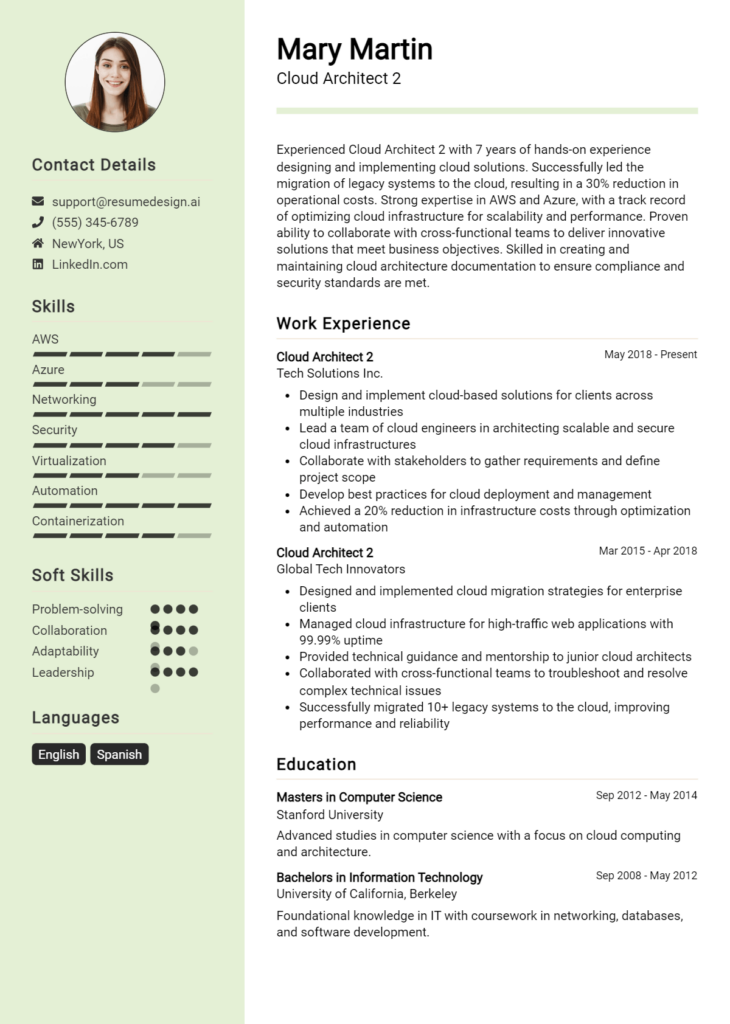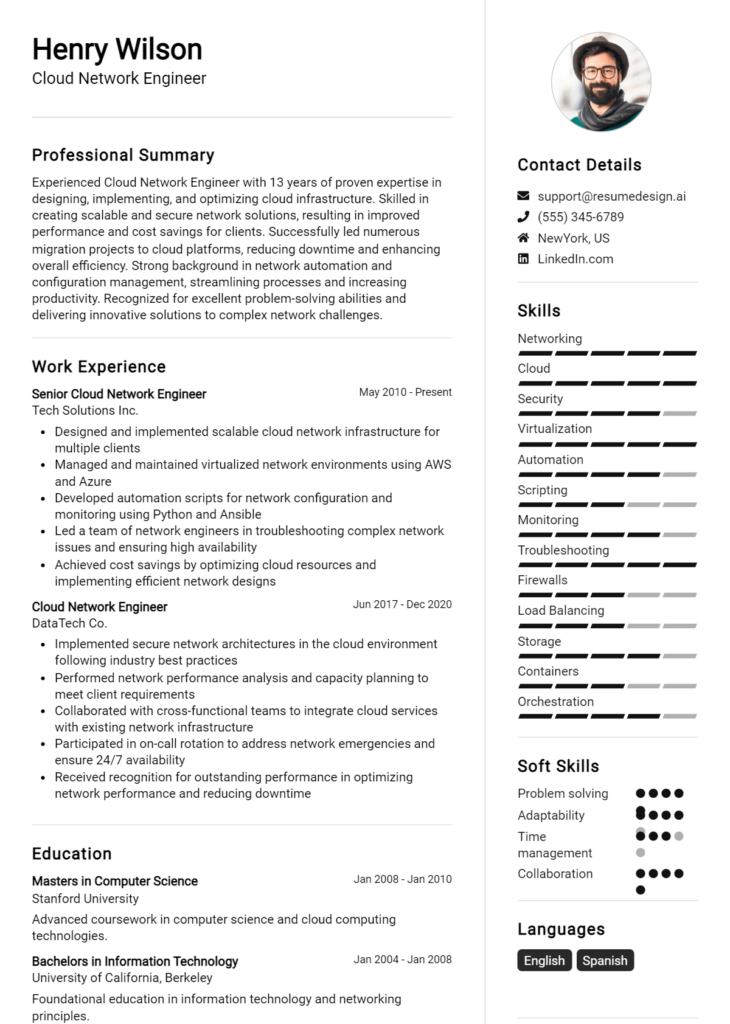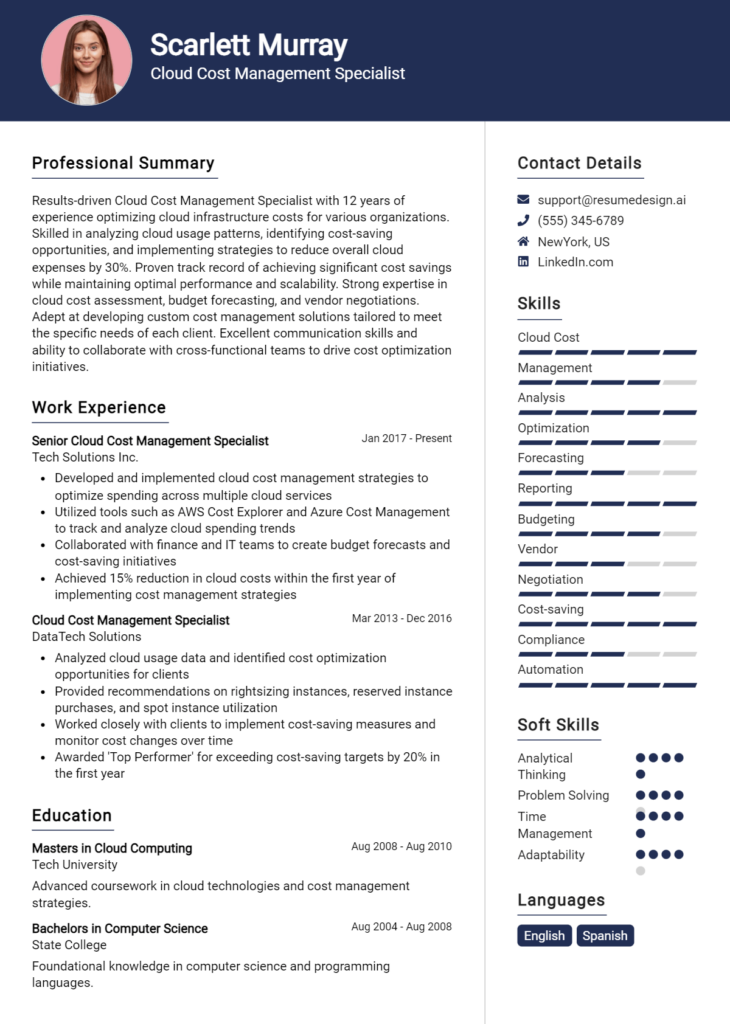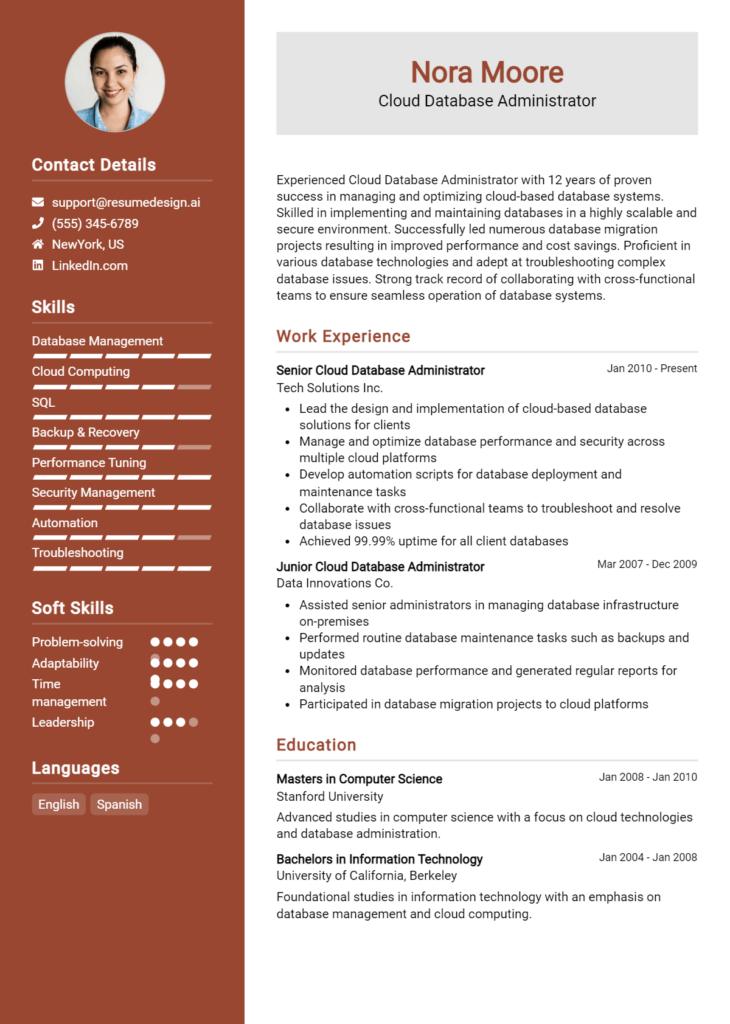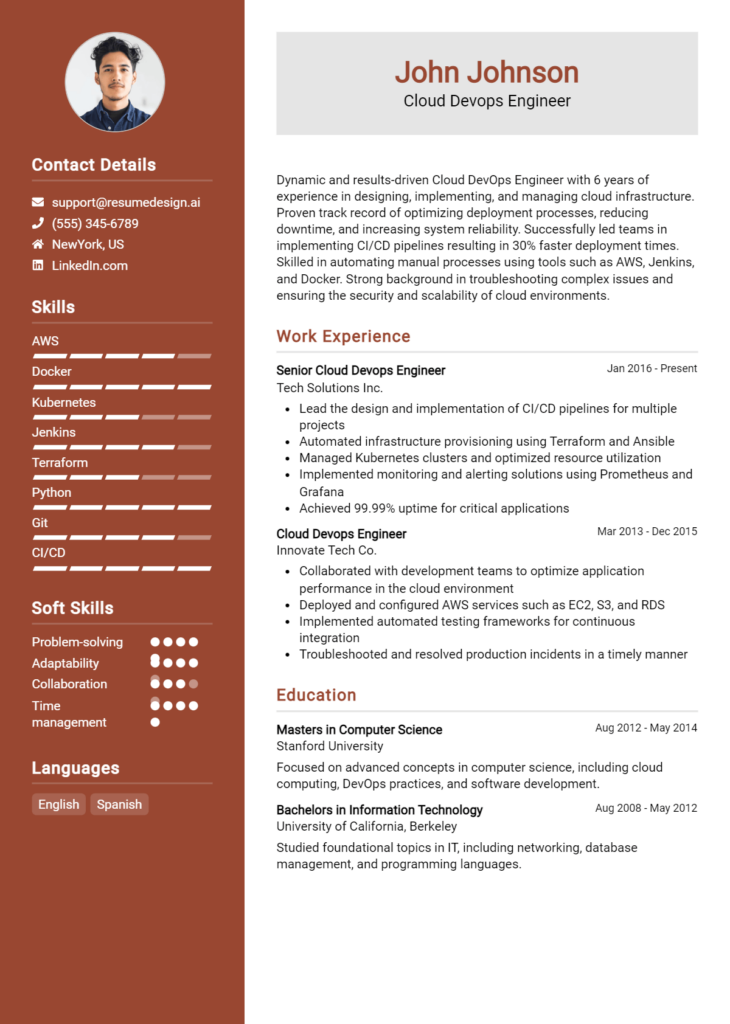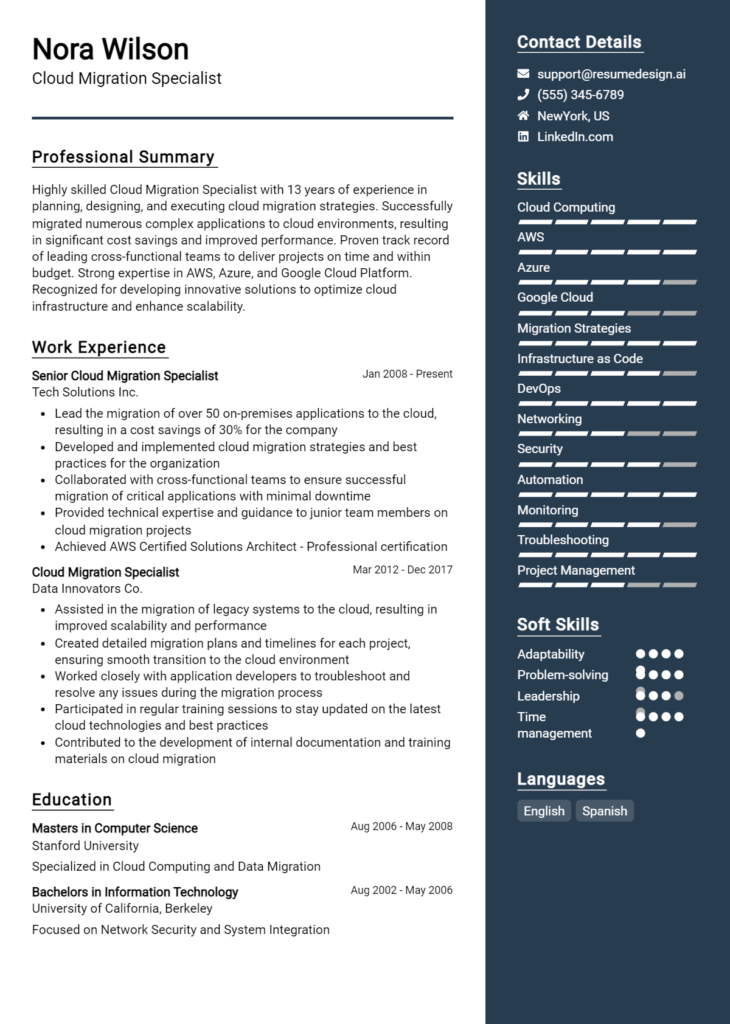Cloud Resilience Engineer Core Responsibilities
A Cloud Resilience Engineer is responsible for designing, implementing, and maintaining resilient cloud architectures that ensure business continuity and disaster recovery. This role requires strong technical skills in cloud platforms, operational expertise in system integration, and exceptional problem-solving abilities. By collaborating across departments such as IT, security, and operations, the engineer ensures that resilience strategies align with organizational goals. A well-structured resume highlighting these qualifications is essential for showcasing a candidate's ability to enhance the organization's operational effectiveness.
Common Responsibilities Listed on Cloud Resilience Engineer Resume
- Design and implement cloud disaster recovery strategies.
- Monitor and optimize cloud infrastructure for resilience.
- Conduct risk assessments and develop mitigation plans.
- Collaborate with cross-functional teams to ensure alignment.
- Develop and maintain documentation for resilience processes.
- Implement automation tools for backup and recovery.
- Perform regular testing of resilience measures.
- Troubleshoot and resolve cloud service outages.
- Stay updated on industry best practices and technologies.
- Provide training and support for staff on resilience protocols.
- Evaluate and recommend cloud service providers.
- Develop metrics and KPIs to measure resilience effectiveness.
High-Level Resume Tips for Cloud Resilience Engineer Professionals
In the competitive field of cloud technology, a well-crafted resume is essential for Cloud Resilience Engineer professionals. Your resume is often the first impression you make on a potential employer, serving as a crucial tool to showcase your technical expertise and accomplishments. It must effectively communicate not only your skills but also your ability to ensure the reliability and resilience of cloud systems. This guide will provide practical and actionable resume tips specifically tailored for Cloud Resilience Engineer professionals, helping you to stand out in a crowded job market.
Top Resume Tips for Cloud Resilience Engineer Professionals
- Tailor your resume to the specific job description by incorporating relevant keywords and phrases.
- Highlight your experience with cloud platforms like AWS, Azure, or Google Cloud, focusing on resilience and disaster recovery projects.
- Quantify your achievements, such as the percentage of uptime you maintained or the cost savings you generated through improved cloud resilience strategies.
- Emphasize relevant certifications, such as AWS Certified Solutions Architect or Certified Cloud Security Professional (CCSP).
- Showcase your understanding of compliance frameworks and best practices in cloud security and data integrity.
- Include specific examples of tools and technologies you’ve used for monitoring and maintaining cloud infrastructure.
- Demonstrate your ability to collaborate with cross-functional teams to implement resilience strategies.
- Highlight any experience with automation tools that enhance cloud resilience, such as Terraform or Ansible.
- Utilize a clean and professional format with clear sections for easy readability.
- Consider adding a summary statement that encapsulates your career objectives and key skills relevant to cloud resilience.
By implementing these tips, you can significantly enhance your resume, increasing your chances of landing a job in the Cloud Resilience Engineer field. A tailored and impactful resume not only showcases your qualifications but also demonstrates your commitment to the role, making you a more attractive candidate to potential employers.
Why Resume Headlines & Titles are Important for Cloud Resilience Engineer
In the competitive field of cloud technology, a Cloud Resilience Engineer plays a critical role in ensuring the reliability and availability of cloud services. A well-crafted resume headline or title is essential for candidates in this field as it serves as the first impression for hiring managers. A strong headline can immediately capture attention and succinctly summarize a candidate's key qualifications in a single impactful phrase. This vital element should be concise, relevant, and directly aligned with the job being applied for, effectively showcasing the candidate's expertise in cloud resilience and their suitability for the role.
Best Practices for Crafting Resume Headlines for Cloud Resilience Engineer
- Keep it concise: Aim for a headline that is no longer than 10 words.
- Be role-specific: Use specific terms related to cloud resilience engineering.
- Highlight key strengths: Include your most relevant skills or experiences.
- Use action-oriented language: Start with strong verbs that convey proactivity.
- Include relevant certifications: Mention any pertinent certifications or qualifications.
- Avoid jargon: Use clear language that can be easily understood by hiring managers.
- Tailor for each application: Customize your headline for the specific job you are applying for.
- Showcase accomplishments: If possible, highlight measurable achievements in your field.
Example Resume Headlines for Cloud Resilience Engineer
Strong Resume Headlines
"Certified Cloud Resilience Engineer with 5+ Years of Experience in Disaster Recovery"
"Expert in Multi-Cloud Strategies and High-Availability Solutions"
"Proven Track Record in Implementing Robust Cloud Security Protocols"
Weak Resume Headlines
"Engineer Looking for a Job"
"Cloud Professional"
The strong headlines are effective because they clearly convey a candidate’s specific skills, experience, and certifications relevant to the Cloud Resilience Engineer role, making them immediately appealing to hiring managers. In contrast, the weak headlines lack specificity and fail to communicate the candidate's qualifications, making them forgettable and less likely to resonate with employers. A well-designed headline can significantly enhance a resume's impact, while vague or generic titles can diminish a candidate's chances of standing out in a crowded job market.
Writing an Exceptional Cloud Resilience Engineer Resume Summary
A resume summary is a crucial component of a Cloud Resilience Engineer's application, serving as the first impression that hiring managers encounter. A well-crafted summary can quickly capture attention by highlighting key skills, relevant experience, and notable accomplishments that align with the job requirements. It should be concise and impactful, tailored specifically to the position being applied for, ensuring that the candidate stands out in a competitive job market. An effective summary not only showcases technical expertise but also demonstrates how the candidate's contributions can enhance the organization's cloud resilience strategy.
Best Practices for Writing a Cloud Resilience Engineer Resume Summary
- Quantify achievements: Use specific metrics to demonstrate your successes, such as uptime percentages, cost savings, or performance improvements.
- Focus on relevant skills: Highlight essential skills that are directly applicable to cloud resilience, such as disaster recovery, cloud architecture, and security protocols.
- Tailor the summary: Customize your summary for each job application to reflect the specific requirements and responsibilities outlined in the job description.
- Use industry terminology: Incorporate relevant jargon and keywords that resonate with hiring managers and applicant tracking systems.
- Keep it concise: Aim for 3-5 sentences that effectively summarize your qualifications without overwhelming the reader.
- Showcase problem-solving abilities: Highlight experiences where you successfully addressed challenges related to cloud resilience and risk management.
- Incorporate soft skills: Mention interpersonal skills like teamwork, communication, and adaptability that are essential in collaborative cloud environments.
- Maintain a professional tone: Ensure that the summary reflects professionalism and aligns with the corporate culture of the organization.
Example Cloud Resilience Engineer Resume Summaries
Strong Resume Summaries
Results-driven Cloud Resilience Engineer with over 7 years of experience in designing and implementing robust disaster recovery strategies, achieving a 99.9% uptime across cloud services. Proven expertise in AWS and Azure environments, having reduced recovery time objectives (RTO) by 40% through innovative automation techniques.
Detail-oriented Cloud Resilience Engineer skilled in developing high-availability solutions for mission-critical applications. Successfully led a cross-functional team to deploy a multi-region architecture that increased system resiliency by 30% and decreased operational costs by 25% within one year.
Dynamic Cloud Resilience Engineer with a strong background in cloud security and compliance. Instrumental in implementing a comprehensive risk management framework, resulting in a 50% reduction in vulnerabilities and a successful audit by external regulators.
Weak Resume Summaries
Cloud Resilience Engineer with some experience in cloud technologies and a desire to improve skills in the field.
Experienced engineer looking to work in cloud resilience, interested in leveraging skills and knowledge for a challenging position.
The strong resume summaries are considered effective because they provide specific, quantifiable achievements and directly relate to the role of a Cloud Resilience Engineer. They highlight relevant skills and experiences that demonstrate the candidate’s capabilities and contributions. In contrast, the weak summaries lack detail, fail to quantify outcomes, and are too generic, making them less impactful and memorable to hiring managers.
Work Experience Section for Cloud Resilience Engineer Resume
The work experience section of a Cloud Resilience Engineer resume is critical, as it provides potential employers with insights into the candidate's technical expertise, leadership capabilities, and their track record of delivering high-quality products. This section not only highlights the candidate's hands-on experience with cloud technologies, disaster recovery, and resilience strategies but also showcases their ability to manage teams effectively and implement best practices in cloud operations. By quantifying achievements and aligning their experience with industry standards, candidates can demonstrate their value and suitability for the role, making a compelling case for their hiring.
Best Practices for Cloud Resilience Engineer Work Experience
- Emphasize technical skills relevant to cloud resilience, such as disaster recovery planning, cloud architecture, and data integrity protocols.
- Quantify achievements with specific metrics, such as the reduction of downtime by a certain percentage or successful recovery time objectives (RTO).
- Highlight leadership experience in managing cross-functional teams and projects that demonstrate collaboration and effective communication.
- Use industry-standard terminology and frameworks, such as ITIL, NIST, or ISO, to align your experience with best practices.
- Include specific technologies and tools used in your roles, such as AWS, Azure, or Kubernetes, to showcase your technical proficiency.
- Provide context for your achievements by explaining the challenges faced and how your contributions led to successful outcomes.
- Tailor your work experience to the job description, ensuring that your most relevant roles and achievements are highlighted.
- Keep descriptions concise and focused, using action verbs to convey impact and responsibility effectively.
Example Work Experiences for Cloud Resilience Engineer
Strong Experiences
- Led a team in migrating 100+ applications to a multi-cloud environment, achieving a 30% reduction in operational costs while improving system uptime by 15%.
- Developed and implemented a comprehensive disaster recovery plan that reduced recovery time from 48 hours to under 4 hours, ensuring critical business continuity.
- Collaborated with cross-functional teams to optimize cloud resource allocation, resulting in a 25% increase in cost efficiency and a 20% enhancement in performance metrics.
Weak Experiences
- Worked on cloud projects that involved various technologies.
- Participated in team meetings discussing cloud resilience strategies.
- Helped with the implementation of cloud solutions.
The examples provided illustrate the difference between strong and weak work experiences. Strong experiences are characterized by clear, quantifiable outcomes, the demonstration of leadership in technical projects, and collaboration with teams to achieve significant results. In contrast, weak experiences lack specificity, do not quantify achievements, and fail to convey the candidate's impact or expertise, making them less compelling to potential employers.
Education and Certifications Section for Cloud Resilience Engineer Resume
The education and certifications section in a Cloud Resilience Engineer resume is crucial as it showcases the candidate's academic background and highlights their commitment to continuous learning in a rapidly evolving field. This section not only provides potential employers with insights into the candidate's foundational knowledge but also emphasizes industry-relevant certifications and specialized training that demonstrate a proactive approach to skill enhancement. By including relevant coursework and certifications, candidates can significantly bolster their credibility and align their qualifications with the demands of the Cloud Resilience Engineer role.
Best Practices for Cloud Resilience Engineer Education and Certifications
- Focus on relevant degrees such as Computer Science, Information Technology, or Cloud Computing.
- Include industry-recognized certifications like AWS Certified Solutions Architect or Microsoft Certified: Azure Solutions Architect Expert.
- Highlight any specialized training in cloud architecture, disaster recovery, or data protection techniques.
- Provide details on relevant coursework that aligns with cloud resilience concepts, such as cloud security or systems engineering.
- Ensure certifications are current and reflect the latest technologies and practices in cloud resilience.
- List certifications in a clear format, including the name of the certification, issuing organization, and date obtained.
- Consider adding participation in workshops, webinars, or conferences that enhance knowledge in cloud resilience.
- Keep the section organized and concise to maintain readability and impact.
Example Education and Certifications for Cloud Resilience Engineer
Strong Examples
- Bachelor of Science in Computer Science, XYZ University, 2021
- AWS Certified Solutions Architect – Associate, Amazon Web Services, Obtained March 2022
- Certified Kubernetes Administrator (CKA), Cloud Native Computing Foundation, Obtained July 2023
- Coursework in Cloud Security and Disaster Recovery Planning, ABC Online Learning Platform, Completed 2022
Weak Examples
- Bachelor of Arts in English Literature, XYZ University, 2020
- CompTIA A+ Certification, CompTIA, Obtained January 2021
- Basic HTML and CSS Online Course, Unrelated to Cloud Technologies, Completed 2021
- Certification in Microsoft Word, Microsoft, Obtained March 2020
The examples provided highlight the distinction between strong and weak qualifications. Strong examples showcase relevant degrees and current certifications that align with the responsibilities of a Cloud Resilience Engineer, emphasizing the candidate's readiness for the role. In contrast, the weak examples reflect outdated or unrelated qualifications that do not contribute to the candidate's credibility in the field, making them less appealing to potential employers.
Top Skills & Keywords for Cloud Resilience Engineer Resume
As the demand for robust cloud infrastructure continues to rise, the role of a Cloud Resilience Engineer has become increasingly vital in ensuring that organizations can withstand and recover from potential disruptions. A well-crafted resume for this position should not only highlight technical expertise but also emphasize the essential skills that contribute to effective cloud resilience strategies. Employers look for candidates who possess a blend of both soft and hard skills to ensure that systems remain operational and reliable even in the face of challenges. By showcasing these skills, candidates can significantly enhance their appeal and demonstrate their readiness to tackle the complexities of cloud environments.
Top Hard & Soft Skills for Cloud Resilience Engineer
Soft Skills
- Problem-solving
- Critical thinking
- Communication
- Team collaboration
- Adaptability
- Attention to detail
- Time management
- Project management
- Customer service orientation
- Leadership
Hard Skills
- Cloud architecture design
- Disaster recovery planning
- Backup and restoration techniques
- Cloud security protocols
- Infrastructure as Code (IaC)
- Knowledge of cloud platforms (AWS, Azure, GCP)
- Networking fundamentals
- Automation tools (Terraform, Ansible)
- Monitoring and performance tuning
- Scripting languages (Python, Bash)
In crafting your resume, it's essential to integrate your skills and relevant work experience to present a comprehensive picture of your qualifications as a Cloud Resilience Engineer. By doing so, you can effectively position yourself as a strong candidate in this competitive field.
Stand Out with a Winning Cloud Resilience Engineer Cover Letter
I am excited to apply for the Cloud Resilience Engineer position at [Company Name] as advertised on [Job Portal/Company Website]. With a robust background in cloud infrastructure management and a strong commitment to maintaining high availability and disaster recovery protocols, I am confident in my ability to contribute effectively to your team. My experience in designing resilient cloud architectures, coupled with my proactive approach to risk assessment and mitigation, aligns perfectly with the goals of [Company Name].
Throughout my career, I have successfully implemented cloud resilience strategies that have significantly minimized downtime and ensured business continuity. At my previous role with [Previous Company Name], I led a team to develop a multi-cloud strategy that reduced our recovery time objective (RTO) by over 50%, while also enhancing our overall system performance. My hands-on experience with cloud platforms such as AWS, Azure, and Google Cloud, along with my proficiency in automation tools like Terraform and Ansible, enables me to create and manage scalable, resilient cloud solutions efficiently.
I am particularly drawn to [Company Name] because of your commitment to innovation and excellence in cloud services. I admire your recent initiatives in [specific project or technology relevant to the company], and I am eager to bring my expertise in cloud resilience to help further enhance your offerings. I believe my skill set in continuous monitoring and performance optimization will add value and ensure that your clients' services remain reliable and accessible.
Thank you for considering my application. I look forward to the opportunity to discuss how I can contribute to the ongoing success of [Company Name] as a Cloud Resilience Engineer. I am excited about the possibility of collaborating with your talented team to create resilient cloud solutions that meet the evolving needs of your clients.
Common Mistakes to Avoid in a Cloud Resilience Engineer Resume
When crafting a resume for the role of a Cloud Resilience Engineer, it’s essential to present a clear and compelling narrative that highlights your technical skills, experience, and problem-solving capabilities. However, many candidates fall into common pitfalls that can diminish the effectiveness of their resumes. Avoiding these mistakes can significantly enhance your chances of standing out to potential employers in this competitive field.
Vague Job Descriptions: Using generic job descriptions instead of detailing specific responsibilities and achievements can lead to a lack of clarity about your skills and contributions.
Ignoring Keywords: Failing to incorporate relevant keywords from the job description can result in your resume being overlooked by Applicant Tracking Systems (ATS) that filter candidates based on specific terms.
Overlooking Soft Skills: While technical expertise is crucial, neglecting to showcase soft skills such as communication, teamwork, and adaptability can paint an incomplete picture of your capabilities.
Lack of Quantifiable Achievements: Simply listing duties without quantifying your achievements (e.g., improved system uptime by 30%) does not effectively demonstrate the impact of your work.
Inconsistent Formatting: Using inconsistent fonts, sizes, or layouts can make your resume look unprofessional and difficult to read, detracting from the content itself.
Too Much Technical Jargon: While it's important to demonstrate your technical knowledge, excessive jargon can alienate readers who may not be familiar with specific terms or technologies.
Neglecting Updates: Failing to regularly update your resume with recent projects, certifications, or skills can make it feel stale and less relevant to current job market demands.
Omitting Relevant Certifications: Not highlighting relevant certifications (like AWS Certified Solutions Architect, Azure Architect, etc.) can lead to missed opportunities, as these credentials often hold significant value in the cloud resilience field.
Conclusion
As a Cloud Resilience Engineer, your role is critical in ensuring the availability, reliability, and performance of cloud-based systems. Throughout this article, we explored essential skills such as disaster recovery planning, fault tolerance, and risk assessment. We also discussed the importance of staying updated with the latest cloud technologies and methodologies to effectively mitigate risks and enhance system resilience.
To stand out in this competitive field, your resume must reflect not only your technical expertise but also your problem-solving abilities and experience in implementing robust cloud solutions. Remember, a well-crafted resume can significantly impact your chances of landing your dream job.
Now is the perfect time to review and refine your Cloud Resilience Engineer resume. To assist you in this process, consider utilizing a variety of available resources, including resume templates, a user-friendly resume builder, tailored resume examples, and professional cover letter templates. These tools can help you create a compelling resume that highlights your strengths and aligns with industry standards. Take action today to elevate your job application and secure your next opportunity in cloud resilience engineering!

